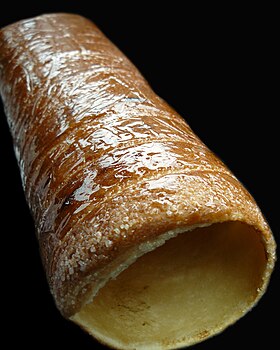food.wikisort.org - Mets
Le kürtőskalács (en hongrois, [ˈkyɾtøːʃkɒlaːtʃ]) ou cozonac secuiesc (en roumain) est un gâteau à la broche hongrois[1] originaire de la Transylvanie[2], région aujourd'hui située au centre et au nord-ouest de la Roumanie. Il se présente sous la forme d'une brioche caramélisée de forme conique tronquée cuite à la broche sur un feu. Le kürtőskalács est vendu dans les pâtisseries mais plus souvent il est préparé par des vendeurs de rue, de plage ou de foire.
| Kürtőskalács | |

| |
| Autre(s) nom(s) | Cozonac secuiesc, chimney cake |
|---|---|
| Lieu d’origine | Transylvanie |
| Place dans le service | Dessert |
| modifier |
|
Il existe une variante tchécoslovaque : trdelník.
Étymologie
Le nom vient du mot hongrois kürtő, « tuyau de poêle[3] », cheminée, dérivé de kürt, « cor », corne, et de kalács « brioche ».
Préparation
Le kürtőskalács est composé d'une bande de pâte cuite sur une broche en bois qui tourne lentement sur un feu. La pâte est parfumée aux épices, généralement de la cannelle, puis garnie de noix ou d'amandes et saupoudrée de sucre. Le sucre est caramélisé à la surface, créant ainsi une belle croûte.
- Cuisson à la broche.
- Détail de la cuisson.
Notes et références
- Louis Craig Cornish, Transylvania in 1922: report of the commission sent by the American and British Unitarian churches to Transylvania in 1922, Eric Cherry, (lire en ligne), p. 45.
- Iván Balassa et Gyula Ortutay, Hungarian Ethnography and Folklore: Bread and Milk Loaf, Budapest, Corvina Kiado, , 818 p. (lire en ligne).
- George Lang, The Cuisine of Hungary, Atheneum, (lire en ligne), p. 112.
Voir aussi
Articles connexes
- Gâteau à la broche
- Spettekaka
- Trdelník
- Alimentation et gastronomie
- Portail de la Roumanie
- Portail de la Hongrie
На других языках
[en] Kürtőskalács
Kürtőskalács (Hungarian: [ˈkyrtøːʃkɒlaːt͡ʃ] (listen); sometimes improperly rendered as Kurtosh Kalach; Romanian: Colac/Cozonac secuiesc; German: Baumstriezel) is a spit cake specific to Hungarians from Transylvania, more specifically the Székelys.[1] Originally popular in the Hungarian-speaking regions of , more predominantly the Székely Land,[2] it became popular in both, Hungary and Romania.[3] The first written record dates back to 1679 and was found in the village of Úzdiszentpéter (now Sânpetru de Câmpie), while the first recipe appears in a manuscript cookbook dated in 1781.[1] Earlier a festive treat, now it is part of everyday consumption.[4] In Transylvania, a similar pastry to Kürtőskalács is Baumstriezel, originating from the Saxon communities.[es] Kürtőskalács
El kürtőskalács o kürtős kalács es un pastel húngaro. Se cocina sobre un cilindro unido a un pincho que se pone sobre un fuego abierto. En las últimas décadas, es popular cocinarlo en hornos especiales de gas o de electricidad. Originalmente es de Transilvania, y es famoso como el dulce húngaro más antiguo conocido. El kürtőskalács se vende en panaderías, pastelerías e incluso puestos callejeros.- [fr] Kürtőskalács
[ru] Кюртёшкалач
Кюртёшкалач (венг. kürtőskalács) — традиционная для румынских венгров из Трансильвании выпечка цилиндрической формы, приготавливаемая обычно над открытым огнём. Кюртёшкалач — неотъемлемый элемент венгерских праздников и массовых мероприятий, например, рождественского базара. Кюртёшкалач также готовят в некоторых булочных и кафе. Посыпанный сахаром кюртёшкалач чаще всего встречается с ванилью и корицей. В Чехии и Словакии аналогичная выпечка именуется трдельник.Другой контент может иметь иную лицензию. Перед использованием материалов сайта WikiSort.org внимательно изучите правила лицензирования конкретных элементов наполнения сайта.
WikiSort.org - проект по пересортировке и дополнению контента Википедии

